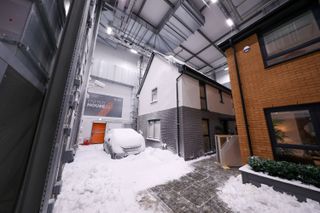在实验设计的“老大哥”的房子to move us towards zero carbon living
The houses are inside a large black box where the weather can be changed to go as low as -20C or up to 40

A pioneering facility designed to help develop even more energy-efficient homes has been opened by the University of Salford.
Energy House 2.0 is a pair of climate-controlled chambers containing two detached houses built with the aid of developers Bellway Homes and Barratt Developments, as well as construction manufacturer Saint-Gobain, at the university’s Frederick Road Campus in Salford.
The £16 million project comes as British householders face record energy bills. Researchers say the project will uncover the most effective ways to reduce energy costs and help to meet new standards that require a significant reduction inembodied carbonemissions for new homes from 2025.
What is the project and why have they built a house inside a warehouse?

Energy House 2.0 will research and test, in tightly controlled conditions, new ways of powering, heating, and insulating homes, making them more energy-efficient. The two chambers are each big enough to fit 24 double decker buses with room to spare.
The temperature in the chambers can go as low as -20C or up to 40C and can generate strong wind, rain, and winter conditions using a snow machine.
Jamie Bursnell, Group Innovation and Technical Manager for Bellway, said: “This is pioneering research and we were treading on new ground here.
“As we enter the testing phase of the project, what we will be trying to do is to find the balance between lowering carbon emissions and keeping running costs as low as possible.

“This research is aimed at testing out different technologies, exploring the questions ordinary people will have and working out how to take the benefits into their homes.”
Usually, it would take months or years to collect the data needed to evaluate the performance of a new design or technology, but because researchers can precisely control the environment to within half a degree they can gather that data in a few weeks.
That means that accurate results can be achieved quickly and accelerates the innovation process. In addition, the research will understand the impact of multiple technologies in the homes giving a better understanding of how the homes will perform in the real world.
Who will be living inside the houses?
Experiments over the coming year will see people stay in the house, much like TV’s Big Brother and enjoy full amenities, including broadband and Sky TV.
Professor Will Swan, Director of Energy House Labs at the University of Salford said: “The growing challenges of climate change and the cost-of-living crisis mean we need to consider how we build and operate our homes. Energy House 2.0 mission is to work with industry and policy makers to provide evidence for what works in meeting these challenges.
“Energy efficient, high performing homes can change people’s lives. The importance of this agenda is one of the main reasons behind the University of Salford’s major investment in Energy House 2.0, which is a critical piece of research infrastructure that can help us find solutions to these problems."


Which eco features are they using to make the home zero carbon?
The homes feature a range of new technologies, each of which could contribute to lowering the amount of carbon produced when a home is built, and the carbon footprint of the people who live in the home.
Bellway’s house, named The Future Home, will test the UK’s firstair source heat pump that sits in your loft, along with underfloor, infrared and ambient heating, mechanical ventilation, double versus triple glazing, enhanced insulation, and a prototype shower, which recovers heat from waste-water.
Saint-Gobain has partnered with Barratt Developments on eHome2 which looks at how to deliver zero carbon housing at scale using off-site lightweight construction solutions.
eHome2 is piloting the use of heating and ventilation technologies as well as smart technology to enable occupants to change the temperature and turn on the shower at the click of a button. The house has a host of features, including weberwall brick, a high-performing timber frame system from Scotframe and Pasquill’s Posi-JoistTM floor cassettes that allow for the integration of mechanical ventilation and heat recovery systems (MVHR).


Professor Will Swan, director of Energy House Labs at the University of Salford said: “The growing challenges of climate change and the cost-of-living crisis mean we need to consider how we build and operate our homes.
“Energy House 2.0 mission is to work with industry and policy makers to provide evidence for what works in meeting these challenges.
“Energy-efficient, high-performing homes can change people’s lives. The importance of this agenda is one of the main reasons behind the University of Salford’s major investment in Energy House 2.0, which is a critical piece of research infrastructure that can help us find solutions to these problems.
“我们已经真正的尖端研究world impact and as the cost of gas and electricity keeps going up and up this work is even more important to create a sustainable and economically viable future for this country and the world.”

Get the Homebuilding & Renovating Newsletter
Bring your dream home to life with expert advice, how-to guides and design inspiration, direct to your inbox.
Sam is based in Coventry and has been a news reporter for nearly 20 years. His work has featured in the Mirror, The Sun, MailOnline, the Independent, and news outlets throughout the world. As a copywriter, he has written for clients as diverse as Saint-Gobain, Michelin, Halfords Autocentre, Great British Heating, and Irwin Industrial Tools. During the pandemic, he converted a van into a mini-camper and is currently planning to convert his shed into an office and Star Wars shrine.
Bring your dream home to life with expert advice, how-to guides and design inspiration, direct to your inbox.
谢谢你注册住宅建筑。你会receive a verification email shortly.
There was a problem. Please refresh the page and try again.
